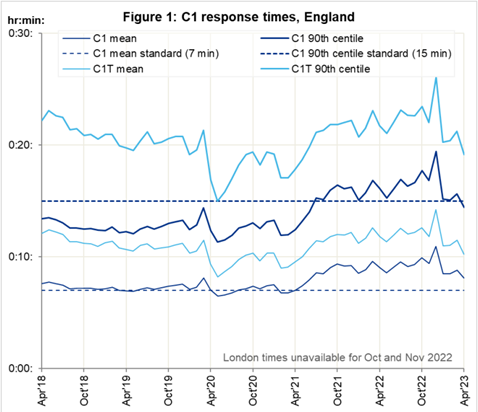
Max Cosstick, A Senior Litigation Executive in the Clinical Negligence Department at Express Solicitors
By Max Cosstick, A Senior Litigation Executive in the Clinical Negligence Department at Legal Futures Associate Express Solictors
In January of this year, it was widely reported in the national press that, in 2022, more than 43,000 people in need of urgent help were dead by the time an ambulance arrived. This shocking statistic was gained from a Freedom of Information request submitted by the Liberal Democrats to ambulance trusts in England.
The statistics showed the North West of England to be the worst offender with 8,450 patients dead on arrival of an ambulance in 2022.
A study completed by NHS England (in 2013) into emergency care resulted in the development of the ‘New Ambulance Standards’ in 2017. This introduced a set of pre-triage questions designed to ascertain which patients are in most need of urgent help. Patients are put into 1 of 4 categories:
- Category 1 (C1): Calls from people with life-threatening illnesses or injuries — this could include cardiac or respiratory arrest, or severe allergic reactions.
- Category 2 (C2): Emergency calls — this could include stroke patients or cases of severe chest pain or burns.
- Category 3 (C3): Urgent calls — this could be a call related to a person in the late stages of labour, or with minor burns or diabetes.
- Category 4 (C4): Less urgent calls — this could include incidents of diarrhea and vomiting, and urine infections.
The New Ambulance Standards state that C1 calls should be responded to within 7 minutes and C2 calls within 18 minutes. Further, 90% of response times should not fall below 15 minutes for C1 calls and 40 minutes for C2 calls.
NHS England releases updated statistics each month demonstrating how ambulance services are performing by way of ‘Ambulance Quality Indicators’. The statistical note – published 12th January 2023 –shows that the average response time for C1 calls in December 2022 was 10 minutes 57 seconds, and C1 calls at the 90th centile was a staggering 19 minutes 25 seconds, which is the worst performance since the categories were introduced in 2017. In the early part of 2023, performance improved slightly and the latest statistical note — published on 11th May 2023 — showed the average response time for C1 calls being 8 minutes 7 seconds, and C1 calls at the 90th centile 14 minutes 27 seconds. Perhaps the most significant fact is that the average response time for C1 calls has been steadily rising for the last 3 years.

By way of explanation, ‘C1T’ is the time for emergency transport for the patient to arrive on scene, where as C1 includes emergency response vehicles carrying ambulance staff who can provide clinical care at the scene.
For the system to work, the public rely not only on there being transport/response vehicles available when required, but also on the most urgent cases being identified as such. Express Solicitors represented the estate and children of a lady who died of cardiac arrest whilst suffering with severe bilateral pneumonia. The deceased’s partner had first called 999 when she developed shortness of breath, abnormal breathing, and feelings of profound sickness.
The correct questions were not asked of the deceased’s partner to enable him to properly convey her condition, leading to him being advised no ambulance would be sent and that he should call 111 or contact the deceased’s GP. A second call was made around 1 hour 45 minutes later when the deceased stopped breathing; CPR was given prior to the arrival of paramedics around 20 minutes later, at which point the deceased was given adrenaline and glucose. The deceased was pronounced dead shortly after arriving at hospital some 3 hours 40 minutes after the first 999 call was made.
The deceased left behind two very young children, one of which had special needs. Both children required care, and — under the ‘Fatal Accident’s Act 1976’ — Express Solicitors were able to secure a significant award for the deceased’s children for dependency.
This heartbreaking case only further highlights the current failures of the NHS when it comes to rapid response for life threatening emergency calls.
With the current difficulties of long wait times following emergency calls, lengthy queues in accident and emergency departments, and strikes, it is hard to be optimistic about the current state of emergency care in England. Had the Liberal Democrats not requested the statistics from ambulance services in England, then the public may not have been given the opportunity to see how bad things truly are. However, it is uncomfortable to see the topic of emergency care so politicised.
Whichever way you vote, we need a system which provides health care professionals with the resources and training they need to do their jobs and, more importantly, one which keeps the public safe. The public rely on the emergency services in their times of most need, and, at the moment, they are being failed.












